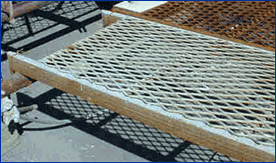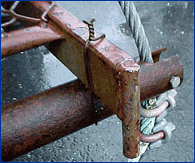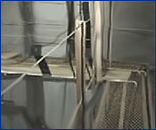Shipyard Employment eTool
Hanging Staging (Marine) >> Key Components: Considerations Component 4. Planking
Key Components: Considerations
Component 4. Planking
Specifications for Planking or "Bedsprings"
The standing surfaces typically used in marine hanging staging are of a specialized design and are constructed for hard use. Referred to in the industry as "bedsprings" by virtue of their appearance and material make-up, they vary in length between 2 and 10 feet, depending on desired platform length.
Bedsprings consist of two rails constructed of 1-inch solid steel stock (ASTM 105), 2-inch (OD) 40-gauge steel tubing (ASTM 105) or equivalent, joined by cross members of equivalent strength, spaced between 12 and 27 inches apart, depending on length.
Expanded metal mesh, the standing surface of the bedspring, is welded to the rails and cross members at intervals that prevent no more than 1 inch of downward deflection. The ends of the bedspring rails are equipped with hangers that secure the rails to the staging struts. Bedsprings are wire-tied to the struts at both ends to prevent displacement.

Planking.

Tie wire.
Photo courtesy of VSRA.
Through design criteria established by engineering analyses and failure mode analysis of marine hanging staging components, a duty rating of 500 pounds has been assigned to this type of planking. Thus, no more than two persons and their tools can occupy a single platform at any given time [29 CFR Part 1915.71(b)(1)]. (Note: Relevant engineering analyses were performed or commissioned by the Virginia Ship Repair Association, Inc., or VSRA, and provided to OSHA in association with the preparation of this section of the Ship Repair module of the Shipyard Employment eTool.)

Planking.
Photo courtesy of VSRA.
- Except during installation, disassembly, alteration, or modification of the marine hanging staging system, struts must be fully planked with bedsprings or standing surfaces of equivalent strength and safety characteristics.
- Platforms must be secured to the struts at each end with tie wire to prevent uplift and horizontal movement across the struts [29 CFR Part 1915.71(i)(3)].
- When installing, modifying, or removing platforms, workers who are erecting staging must be protected by personal fall protection equipment when they are exposed to falls of more than 5 feet [29 CFR Part 1915.71(j)(3)].
- Platforms, when ready for scaffold users, should be level to within an inch for every foot of length. For example, a completed platform supported by two struts spaced 7 feet apart should have one end no more than 7 inches higher than the other. The Qualified Person shall ensure that tripping hazards are not created for workers moving from one platform to another [29 CFR Part 1915.81].

